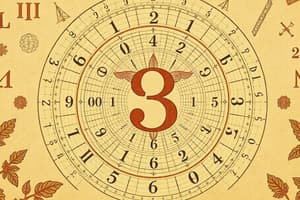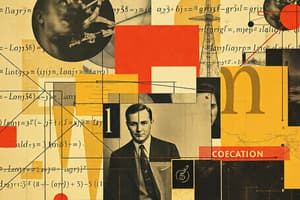Podcast
Questions and Answers
Which of the following numbers is an example of an irrational number?
Which of the following numbers is an example of an irrational number?
- 1/3
- 4
- -5
- √3 (correct)
Which operation is correctly described as repeated addition?
Which operation is correctly described as repeated addition?
- Subtraction
- Addition
- Multiplication (correct)
- Division
What is the correct term for the middle value in an ordered data set?
What is the correct term for the middle value in an ordered data set?
- Range
- Mode
- Mean
- Median (correct)
Which of the following is a characteristic of a function?
Which of the following is a characteristic of a function?
Which of the following represents the perimeter of a rectangle with length 5 and width 3?
Which of the following represents the perimeter of a rectangle with length 5 and width 3?
What is the formula for calculating theoretical probability?
What is the formula for calculating theoretical probability?
Which of the following expressions is a correct representation of factoring?
Which of the following expressions is a correct representation of factoring?
Which type of angle is defined as being less than 90 degrees?
Which type of angle is defined as being less than 90 degrees?
Flashcards are hidden until you start studying
Study Notes
Basic Concepts of Mathematics
1. Numbers
- Natural Numbers: Positive integers (1, 2, 3, ...).
- Whole Numbers: Natural numbers including zero (0, 1, 2, ...).
- Integers: Whole numbers and their negatives (..., -3, -2, -1, 0, 1, 2, 3,...).
- Rational Numbers: Numbers that can be expressed as a fraction (e.g., 1/2, 3/4).
- Irrational Numbers: Numbers that cannot be expressed as a fraction (e.g., √2, π).
2. Basic Operations
- Addition: Combining two or more numbers (e.g., 2 + 3 = 5).
- Subtraction: Finding the difference between numbers (e.g., 5 - 2 = 3).
- Multiplication: Repeated addition (e.g., 4 × 3 = 12).
- Division: Splitting a number into equal parts (e.g., 12 ÷ 4 = 3).
3. Algebra
- Variables: Symbols representing numbers (e.g., x, y).
- Expressions: Combinations of numbers and variables (e.g., 2x + 3).
- Equations: Statements that two expressions are equal (e.g., 2x + 3 = 7).
- Factoring: Breaking down an expression into simpler components (e.g., x² - 9 = (x - 3)(x + 3)).
4. Geometry
- Shapes: Basic shapes include triangles, squares, rectangles, circles.
- Angles: Measured in degrees; types include acute (< 90°), right (90°), obtuse (> 90°).
- Area: The amount of space inside a shape (e.g., Area of a rectangle = length × width).
- Perimeter: The distance around a shape (e.g., Perimeter of a rectangle = 2(length + width)).
5. Statistics
- Mean: Average value of a data set.
- Median: Middle value when data is ordered.
- Mode: Most frequently occurring value in a data set.
- Range: Difference between the highest and lowest values.
6. Probability
- Basic Definition: Measure of the likelihood of an event occurring.
- Formula: P(E) = Number of favorable outcomes / Total number of outcomes.
- Types:
- Theoretical Probability: Based on reasoning (e.g., flipping a coin).
- Experimental Probability: Based on experiments (e.g., frequency of outcomes).
7. Calculus
- Differentiation: Finding the rate of change of a function (e.g., slope of a curve).
- Integration: Finding the total area under a curve.
8. Functions
- Definition: A relation where each input has a single output.
- Types:
- Linear: Graphs a straight line (y = mx + b).
- Quadratic: Graphs a parabola (y = ax² + bx + c).
9. Mathematical Techniques
- Order of Operations: Parentheses, Exponents, Multiplication and Division (left to right), Addition and Subtraction (left to right) (PEMDAS).
- Graphing: Visual representation of equations and functions on a Cartesian plane.
Resources for Further Learning
- Textbooks (basic math, algebra, geometry, calculus)
- Online courses (Khan Academy, Coursera)
- Practice problems (Worksheets, math games)
Basic Concepts of Mathematics
- Natural Numbers are positive whole numbers, starting from 1 (1, 2, 3, ...).
- Whole Numbers include natural numbers and zero (0, 1, 2, ...).
- Integers include all whole numbers and their negative counterparts (..., -3, -2, -1, 0, 1, 2, 3, ...).
- Rational Numbers can be represented as fractions, like 1/2 or 3/4.
- Irrational Numbers cannot be written as fractions and include numbers like √2 and π.
Basic Operations
- Addition combines two or more numbers (e.g., 2 + 3 = 5).
- Subtraction finds the difference between two numbers (e.g., 5 - 2 = 3).
- Multiplication is repeated addition (e.g., 4 × 3 = 12).
- Division splits a number into equal parts (e.g., 12 ÷ 4 = 3).
Algebra
- Variables are symbols representing unknown numbers (e.g., x, y).
- Expressions combine variables and numbers using operations (e.g., 2x + 3).
- Equations state that two expressions are equal (e.g., 2x + 3 = 7).
- Factoring breaks down expressions into simpler components (e.g., x² - 9 = (x - 3)(x + 3)).
Geometry
- Basic shapes include triangles, squares, rectangles, and circles.
- Angles are measured in degrees and categorized as acute (< 90°), right (90°), and obtuse (> 90°).
- Area quantifies the space within a shape (e.g., Area of a rectangle = length × width).
- Perimeter is the total distance around a shape (e.g., Perimeter of a rectangle = 2(length + width)).
Statistics
- Mean is the average value of a data set.
- Median is the middle value when data is arranged in order.
- Mode is the most frequently occurring value in a data set.
- Range is the difference between the highest and lowest values in a data set.
Probability
- Probability measures the likelihood of an event happening.
- The probability formula is: P(E) = Number of favorable outcomes / Total number of outcomes.
- There are two types of probability:
- Theoretical Probability is based on reasoning (e.g., flipping a fair coin).
- Experimental Probability is determined through experiments (e.g., observing the frequency of outcomes).
Calculus
- Differentiation finds the rate of change of a function, representing the slope of a curve at a specific point.
- Integration determines the total area under a curve.
Functions
- A function is a relation where each input has one and only one output.
- Linear functions graph as straight lines (y = mx + b).
- Quadratic functions graph as parabolas (y = ax² + bx + c).
Mathematical Techniques
- Order of Operations follows the acronym PEMDAS: Parentheses, Exponents, Multiplication and Division (from left to right), Addition and Subtraction (from left to right).
- Graphing visually represents equations and functions on a Cartesian plane.
Studying That Suits You
Use AI to generate personalized quizzes and flashcards to suit your learning preferences.



